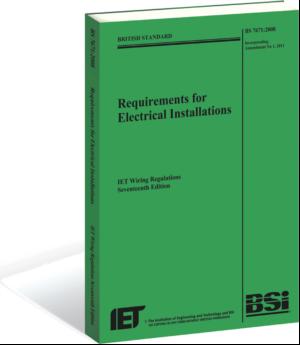Geoff Cronshaw, chief electrical engineer at the IET, highlights the key elements of the
changes to the Periodic Inspection Report – which comes into effect on 1st January
2012 and which workplace safety managers should be
Geoff Cronshaw, chief electrical engineer at the IET, highlights the key elements of the
changes to the Periodic Inspection Report - which comes into effect on 1st January
2012 and which workplace safety managers should be aware of.
The Institution of Engineering and Technology (IET) has
launched the IET Wiring Regulations, 17th Edition, BS
7671:2008 incorporating Amendment No.1, 2011.
Jointly published with BSI, the amended IET Wiring
Regulations sets the standard for all new electrical installations
in the UK and includes topics specific to health and safety;
including the change from the Periodic Inspection Report to
the Electrical Installation Condition Report (EICR).
Changes to the Periodic Inspection Report
The change from the Periodic Inspection Report to the Electrical
Installation Condition Report (EICR) in Appendix 6 of the
amended regulations (Model forms for certification and
reporting) represents a major shift from the 17th Edition of the
Wiring Regulations. The new report, both in terms of its content
and name, is felt to be more descriptive than the previous
Periodic Inspection Report.
It is important for workplace safety managers to be aware of
the changes because the new report applies, not just to
domestic installations, but also to larger
installations, greater than 100 A, which are
often found in the workplace. The key changes
are defined below.
New code and definitions
Within the EICR, new codes and definitions have been
developed with the intention of being clearer - if it's recorded, it's
an issue that should be dealt with. For example, within the
observations section the four codes of the old PIR: 1 (requires
urgent attention), 2 (requires improvement), 3 (requires further
investigation), 4 (does not comply with BS 7671:2008 amended
to…) have been replaced by three codes. These are code 1 danger
present (e.g. bare live wires which can easily be touched), code 2
potentially dangerous (e.g. RCD will not operate correctly when
tested), code 3 improvement recommended (e.g. no 30 mA RCD
for additional protection for socket-outlets used by nonskilled/
non-instructed persons).
Under this new coding
system a summary of the
condition of the installation in
terms of safety should be
clearly indicated in Section E
of the condition report.
Observations, if any, should be
categorised in Section K of the
condition report using the
coding C1 to C3 as
appropriate. Any observations
given a C1 or C2 classification
should result in the overall
condition of the installation
being reported as unsatisfactory, whereas under the 17th edition
only a number 1 (requires urgent attention), allocated to an
observation would normally result in the overall assessment of
unsatisfactory.
New inspection schedule
The new inspection schedule provides a detailed breakdown of the
inspection required on each aspect of the installation to ensure that
the work is carried out in an organised and efficient manner. For
example, the schedule for domestic and similar premises includes
over 60 check points. For installations other than domestic and
similar premises, Appendix 6 includes a list of over 100 examples of
items requiring inspection for an Electrical Installation Condition
Report. Each item listed on the schedule which requires checking
is accompanied with the relevant regulation number for ease of
reference to the wiring regulations. In addition, the form
provides a facility to indicate the outcome of the inspection of
each item with either a tick (acceptable condition), a code C1 or
C2 (unacceptable condition), a code C3 (improvement
recommended), NV (not verified) Lim (limitation) or NA (not
applicable); whereas under the 17th edition the inspection of a
general item would normally only
result in a tick in a box.


